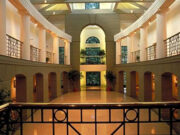The Columbus Museum, serving more than 90,000 visitors annually, is a major artistic center for west central Georgia. As the largest art museum in Georgia outside Atlanta and the only art museum within a forty-mile radius of Columbus, it draws patrons primarily from thirteen Georgia and seven Alabama counties. Accredited by the American Association of Museums, the Columbus Museum offers educational programs for children and adults, changing exhibitions, and related activities. There also is an interactive gallery as well as space for lectures and advanced studio art instruction.
Chartered in 1941 and opened to the public in 1953, the Columbus Museum has been a partner and part of the Muscogee County School District since its beginning. After many years of operating in cramped and outdated facilities, a capital campaign was launched in 1985 to raise $10.5 million for the renovation and enlargement of the present building. The expanded facility opened in April 1989 and increased the size of the museum from 32,000 to 86,000 square feet. The gardens surrounding the museum, designed in the 1920s by the firm founded by the landscape architect Frederick Law Olmsted, have also been renovated.
The museum’s original collection was quite broad, reflecting its purpose as stated in its charter: to serve as a “museum of the arts, crafts, and historical subjects, promoting educational and cultural activities.” In 1992 the trustees narrowed the museum’s emphasis to focus on American fine and decorative art and cultural history. The current collection of more than 16,000 objects relates the rich visual history of American art from the seventeenth century to the present and records the development of the culture and history of the Lower Chattahoochee River Valley.
Pivotal artists represented in the museum are William Merritt Chase, Sanford Gifford, Robert Henri, Eastman Johnson, Hiram Powers, Gilbert Stuart, and John Henry Twachtman. Contemporary artists include Roger Brown, Robert Motherwell, and Robert Rauschenberg; there are major works by such women as Janet Fish, Nancy Grossman, Ida Kohlmeyer, Lee Krasner, Alice Neel, Sarah Miriam Peale, and Joyce Treiman. Mid-twentieth-century artists significant to the Southeast include George Cress, Lamar Dodd, Robert Gwathmey, Carl Holty, Ed Moulthrop, and Howard Thomas. African American artists include Benny Andrews, Radcliffe Bailey, Sam Gilliam, William H. Johnson, and Alma Thomas. Notable decorative arts range from a 1670 Pilgrim-era Boston chest and an 1813 Philadelphia sideboard attributed to Joseph Barry to a group of mid-twentieth-century Eames-designed chairs.
The museum’s historical and archaeological collections present a comprehensive survey of the human occupation of the Chattahoochee River valley, beginning with the prehistoric archaeological record and moving through early settlement, the Civil War (1861-65), Reconstruction, industrial expansion, and the civil rights movement. In informative exhibitions, the collection tells the story of this region and its people via archaeological fragments, costumes, portraits, maps, books, photographs, tools, weapons, household goods, and machinery. The community’s full ethnic and socioeconomic history is presented, with special attention paid to artifacts relating to the Native American presence, African American history, and the story of textile mill laborers.




